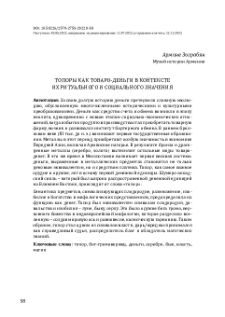Object
Title: Топоры как товаро-деньги в контексте их ритуального и социального значения
Journal or Publication Title:
Date of publication:
Volume:
ISSN:
Official URL:
Additional Information:
Other title:
Axes as commodity-money in the context Of their ritual and social significance
Contributor(s):
Coverage:
Abstract:
During its history, money has undergone a complex evolution due to historical and cultural transformations in the different periods. Money as medium of account and exchange arose in the Neolithic era simultaneously with the new stage of social-economic relations, when the surplus of products takes on a commodity form and the barter exchange developed. In the Early Bronze Age (III millennium BC) the first statements arose, bronze and precious metals appeared in Western Asia including the Armenian Highland. At the same time measurement of weight was created in Mesopotamia, money expressed in metal objects became not only a price equivalent, but also medium of payment. The axe, as the most important tool and weapon, acquires the significance of money. Therefore, the Sumer/Akkadian shekel, which was the widespread unit of currency in Near East, originates from the word “axe”.
Place of publishing:
Москва-Ереван
Publisher:
Институт языкознания РАН ; Институт археологии и этнографии НАН
Format:
Extent:
Identifier:
click here to follow the link ; oai:arar.sci.am:359404
Object collections:
Last modified:
Apr 15, 2024
In our library since:
May 17, 2023
Number of object content hits:
109
All available object's versions:
https://arar.sci.am/publication/384863
Show description in RDF format:
Show description in OAI-PMH format:
-
Армянский гуманитарный вестник=Հայագիտական ուսումնասիրություններ. Պարբերագիր=Bulletin of Armenian Studies (Periodical Journal)
-
Армянский гуманитарный вестник, 2009, 2/3-I
-
Армянский гуманитарный вестник, 2009, 2/3-II
-
Армянский гуманитарный вестник, 2012, 4
-
Армянский гуманитарный вестник, 2021, 7
-
Армянский гуманитарный вестник, 2022, 8 (Специальный выпуск)
-
Армянский гуманитарный вестник, 2022, 9
- Обложка; Редакционная коллегия
- Оглавление
- Культовые памятники из некрополя Кармир Берд
- Эталонные матрицы мерных гирь из Шенгавита
- Арташат – Артаксата: Античный мега-полис в свете новейших археологических изысканий
- Топоры как товаро-деньги в контексте их ритуального и социального значения
- Практики тайных крещений в Советской Армении
- Святые места и досуг: На перекрестке сакрального и профанного (на примере современных религиозных практик Армении)
- «Национальное по содержанию и социалистическое по форме»: Палимпсест мемориалов Советской Армении
- К истории оливы в культуре Ирана
- Письмо Иштар-Шуму-Эреша - Асархаддону (abl 519 = las 13) в контексте прогнозирования внешней и внутренней политики Ассирии
- Франк (европеец) – персонаж армянского и тюркского эпосов
- Сюни-ванк, или церковь св. Григория (VII в.): Попытка нового прочтения скульптурных изображений
- The Attributes of Sacredness of Animals on the Reliefsof Armenia and Georgia (6th-14th Centuries)
- О новонайденном хачкаре из Сергиева Посада
- Требования к авторам
-
Армянский гуманитарный вестник, 2023, 10/1
-
Армянский гуманитарный вестник, 2023, 11/1 (Специальный выпуск)
-
Армянский гуманитарный вестник, 2023, 11/2 (Специальный выпуск)
-
Армянский гуманитарный вестник, 2009, 2/3-I
| Edition name | Date |
|---|---|
| Зограбян, Армине, Топоры как товаро-деньги в контексте их ритуального и социального значения | Apr 15, 2024 |





